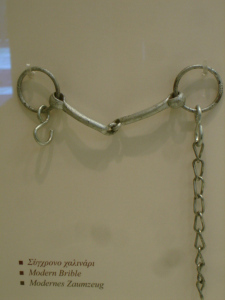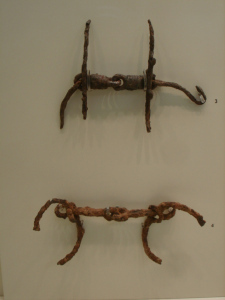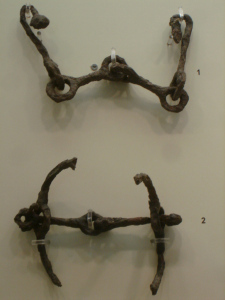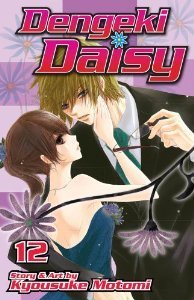S.Q. Eries's Blog, page 59
July 15, 2013
#MSWL: Editor and Agent Manuscript Wish List!
For writers who are querying manuscripts, there’s a new, very handy resource available! Hastag #MSWL was launched on Twitter the end of last month. It stands for Manuscript Wish List and many great agents have weighed in on the type of stories they are currently looking for. If you are on Twitter, you should check it out!
Even if you don’t have a Twitter account, you can still take advantage of it via this link on Tumblr:
http://agentandeditorwishlist.tumblr.com/
You still need to look up each agent’s submission guidelines elsewhere (querytracker.net and agentquery.com can be helpful in addition to the standard Google search), but there’s a lot of great info that might just help a writer find the perfect agent for her manuscript.
Happy querying!


July 12, 2013
Unsung Inventions: Bits
As mentioned in my June 20, 2013 post, I’ve been reflecting on humble yet revolutionary inventions that ancient Greek horsemen lacked, and today’s focus is on bits.
Bits have existed nearly much as long as horsemanship. It helps that horses have that natural gap between their teeth that looks genetically designed to accommodate a bit. But while the bit existed well before the ancient Greeks, their design and use have changed dramatically over the years.
As mentioned in my last post, fitting an ancient Greek bridle properly was critical. The straps of the bridle served to secure the bit in the horse’s mouth. If they were too loose, the horse could take the bit between its teeth (a very bad thing for the rider/driver). But if they were too tight, the bit could harden the horse’s mouth (a very bad thing for the rider/driver and horse). And if you saw fourth century BC Greek bits, you’d see exactly how a horse’s mouth could get damaged.

Modern Snaffle

Ancient Bits

Ancient Bits
Above are some bits I saw at the museum in Olympia. As you can see from the pictures, the basic design is similar to a modern snaffle bit, but they also have those wicked looking points at the ends. According to J.K. Anderson’s Ancient Greek Horsemanship, other ancient bits also included spiked plates and rollers (spiked or smooth). You can find pictures of those in Anderson’s book, and to me, they look more like torture devices than something you’d put into a beloved horse’s mouth.
According to Anderson, the bits were so severe that Greek riders generally kept their reins slack and communicated instead through their seat bones (which is possible because they rode bareback). The only time they would use reins was to enforce a command, and they would immediately disengage once the horse obeyed. Anderson doesn’t comment on driving techniques, but I imagine drivers relied more on voice commands and the whip/driving stick signals with bits like that.
In regard to training horses, trainers would start with a more severe bit first. Once the horse learned to respond to it, they would switch to a smoother one. That might be why the bits on display in Olympia aren’t nearly as spiky as the examples in Anderson’s book.
Severe bits still exist nowadays, but their function has completely changed. Instead of acting as a punishing force to emphasize commands, bit and reins form a constant line of communication with riders applying light continuous tension on their horses’ mouths. Somewhere along the way, either the bits got redesigned or the philosophy of horsemanship changed. Either way, I’m sure the horses are happy not to have spiked plates pressing against their lips.
Next up: horseshoes.


July 5, 2013
Unsung Inventions: Buckles
As mentioned in my June 20, 2013 post, I’ve been reflecting on humble yet revolutionary inventions that ancient Greek horsemen lacked, and today’s focus is on buckles.
Hardly anyone would think of a buckle as an invention nowadays. They’re so ubiquitous it seems as if they’d been with humankind always. But they haven’t. The first buckles came during the time of the Romans. A development in armor, the first buckles were expensive so only the military and the rich could afford them. It wasn’t until the 15th century that a cheaper way of manufacturing them made general use of buckles possible.
Ancient Greek horsemen, however, were completely without buckles. Consider that and then consider how many buckles are used by horsemen. I don’t know the last time you passed a stable, but buckles are everywhere. On bridles, saddles, harness… They not only make it easy to secure tack onto a horse, they allow different animals to share equipment fairly quickly. I was at a horse show in Norco, California, where two animals were using the same harness and cart for the same course. The owner only had a few minutes to switch out the horses, and I was impressed by the speed at which she swapped them out.
But without buckles, what would you have?
In ancient Greek world, the answer was knots. Lots of them. Saddles weren’t an issue because, as mentioned in my previous post, riders went bareback. Securing a bridle properly, however, was critical, especially given the type of bits the Greeks used (more on that later). As such, every bridle was fitted specifically to one horse. None of the straps could be undone or adjusted except for the throatlatch, which was a secured by a quick release knot on the near (right) side.
I’m the type who considers tying shoelaces a chore. I can only imagine how time-consuming it was to tie and retie and adjust all those knots to harness up a chariot team.
So to all you horse folk out there, next time you tighten a girth or lengthen your stirrups leathers pause a moment and hail that handy bit of technology called the buckle.
Next time: bits


June 27, 2013
Unsung Inventions: Stirrups to Cavalries
As mentioned in my last post, ancient Greeks were more likely to think of a charioteer than a jockey at the word “horse racing.” This was partly because Greek sports were essentially peacetime military exercises, and armies used chariots long before mounted units. If you read Homer’s Iliad, there are numerous mentions of chariots, but nary one of a mounted warrior.
To Americans, a charge of the light brigade might seem a lot more practical than chariots rolling about on the battlefield. But again, our ancient Greek predecessors lacked a little thing called stirrups. If you think riding bareback on a galloping, weaving horse sounds hard, imagine doing that holding weapons with arrows flying through the air. War chariots, which were the tanks of their day, each had a driver and an archer. That way one could concentrate on steering while the other could focus on attacking. And if you fell off, stepping into a chariot’s a lot quicker (especially with a partner) than trying to scramble onto the back of a spooked, saddleless horse.
Of course, chariots weren’t without their drawbacks. Namely, they only worked in places where a wheeled vehicle could travel at speed. Given Greece’s terrain, it was only a matter of time before armies started incorporating mounted units.
These early Greek cavalries fought with javelins or a heavy curved slashing sword and used horses that were quick and handy. Their MO was to deliver a lightning strike: charge, attack, and retreat at once so the enemy could not engage them. Prolonged close combat they left to the ranks on foot. Because any extended engagement was liable to unseat their bareback riders.
But once stirrups came along, mounted warfare completely changed. They not only secured rider’s position on a horse’s back, they gave fighters something to brace against if they struck an enemy or sustained a blow. That way, riders could stay in the fray for the long haul, eventually leading to the development of mounted knights and Civil War era cavalries. If you don’t believe that, just imagine a jousting match between bareback riders (LOL).
Next up: buckles.


June 20, 2013
Unsung Inventions: Transistors and Stirrups
While I was watching American Experience’s Silicon Valley segment on PBS, one of the show’s observations really struck me. According to narrative, the success of the Apollo Space Program was only possible because of concurrent advances in computer technology. I’d never looked at it that way, but it’s true. In this age of smart phones, we take electronics for granted, but a 1950s computer took up an entire building and required its own maintenance crew. So constructing a computer small and light enough to fit into a space capsule was a real challenge. Only the advent of the transistor made it possible, and though most people at the time were unaware of that achievement in electronics, they certainly took note when the first man walked on the moon.
There are probably countless examples of such unsung technological advances that revolutionized different arenas, and the equine world has its share. For instance, if I say, “horse racing,” most people will think of jockeys riding Triple Crown races. (Congratulations to Palace Malice for winning the Belmont!) But ancient Greeks were more likely to think of something like this:
That might seem odd to Americans, who are more accustomed to horseback riding than carriage driving. But there are a few reasons for this difference, one of which is a little thing that would hardly catch anyone’s eye nowadays: stirrups.
The ancient Greeks didn’t have stirrups. Stirrups didn’t arrive to Europe until centuries later, probably from Asia. That meant riders went bareback or possibly with a saddle cloth. If you don’t think that’s a big deal, imagine trying to mount a horse by yourself without the benefit of something to stick your feet into. Mounting aside, stirrups give a rider something to brace against.
It’s certainly possible to go galloping bareback. The Boyz’ Mom asserts that going bareback allows for better communication between horse and rider. But Julie who’s a less experienced rider, says that she’d never take her feet out of the stirrups unless she’s on a steady lesson horse. If you’re dealing with a skittish or unfamiliar horse, stirrups can make the difference between staying astride or going airborne.
More on stirrups next time.


June 10, 2013
Manga Review: Bakuman Vol. 19
 Bakuman is the latest collaboration of Ohba and Obata, the creators of the wildly popular Death Note series. Unlike Death Note, Bakuman is more or less grounded in reality, but it is no less entertaining as it follows the ups and downs of a mangaka duo as they strive to make it big in the publishing world!
Bakuman is the latest collaboration of Ohba and Obata, the creators of the wildly popular Death Note series. Unlike Death Note, Bakuman is more or less grounded in reality, but it is no less entertaining as it follows the ups and downs of a mangaka duo as they strive to make it big in the publishing world!
This series is a personal favorite of mine, and Viz Media has just released Volume 19. (My reviews of earlier Bakuman volumes can be found here.)
The Review
Spoiler Alert!!!
Bakuman continues its renewed Eiji rivalry arc in Volume 19. First it’s the battle for survey results, then it’s a battle for graphic novel sales, and it finally culminates in a battle for a Jump anime slot. These “battles” though are relatively short. The start of the graphic novel sales battle to the conclusion of the anime battle takes only four chapters. The pages though are crammed with dialogue and panels, and it feels a bit like the creators were rushing through to get to the next, and likely final, arc of the series.
The driving force behind Ashirogi’s anime aspirations has been Moritaka’s dream of marrying Miho, so once Reversi’s anime slot is locked in, the story shifts back to Moritaka and Miho’s endangered species-like relationship (as Akito calls it). Of course our pair can’t get to happily ever after so easily, and a new obstacle arises in the form of Internet fandom backlash.
It starts out small enough with an indiscreet blog post stating that Ashirogi-sensei is actually a two-person team, but that quickly snowballs into a tabloid scandal that plunges the Jump office into uproar and threatens Miho’s career. Ishizawa, who’s definitely taken a turn for the disgusting, reappears to ignite the sparks of disaster, and interestingly, Fukuda inadvertently fans the flames. I never pinned the bad-boy motorcycle mangaka as the romantic type, but apparently he is and unfortunately gets carried away by his emotions. As the storm rages, Miho exudes calm as usual, but so does Moritaka, and it’s actually Akito who gets all riled up about the situation. (I know the chances are slim, but I’m hoping for a replay of Akito’s Ishizawa punch!) At any rate, Bakuman looks to be heading toward a strong finish with Miho and Moritaka caught between denying their relationship and achieving their dreams.
In Summary
Bakuman is at its penultimate volume, and as much as I’ve enjoyed the series, it really does feel like time for it to come to a close. Moritaka’s been in pursuit of his dream of marrying Miho for ten years, and at this point, Akito’s already married and most of their rivals have animated series. But the course of true love never runs smooth, and Ohba-sensei does a great job of throwing yet another obstacle into their path as the story shifts from the Eiji/Ashirogi rivalry to Moritaka and Miho’s hopes for marriage.
First published at the Fandom Post.


May 28, 2013
Manga Review: La Corda d’Oro Vol. #17
 It’s not unusual for a manga to have its origins in a video game, and La Corda d’Oro is one of them. Based off of a Koei romance game, it tells the story of ordinary high school girl Kahoko who finds herself competing against five gorgeous male music students because of a magical violin. Viz has released the final volume in the series, and you can read on for the review.
It’s not unusual for a manga to have its origins in a video game, and La Corda d’Oro is one of them. Based off of a Koei romance game, it tells the story of ordinary high school girl Kahoko who finds herself competing against five gorgeous male music students because of a magical violin. Viz has released the final volume in the series, and you can read on for the review.
Back Cover Blurb
While Len studies the violin in Europe, Kahoko swears to keep him in her heart… as her musical inspiration, that is. But could he be something more? Kahoko finds it harder and harder to deny her feelings, but the boys of Seisou Academy seem bent on making her forget about Len. At long last, it’s time for her to make a choice – for music and for love.
The RevieW
La Corda was based on a romance videogame, and although there is some fretting from Kahoko about whether to continue studying violin, the main focus of La Corda’s final volume is the confessions of love and final sentiments from the male cast. Aoi’s “Special Edition” chapter provides a concise summation of everyone’s feelings (including Shoko’s) when he goes around asking everyone what they find attractive about Kahoko. However, the major heartthrobs – Ryotaro, Kazuki, Azuma, and Len – get to have their own heart-to-heart chat with Kahoko.
Although everyone’s completely in character for these scenes, the chapters feel rushed. Kazuki’s moment is only a couple pages tacked on at the end of Ryotaro’s two chapters, and we never get to see the Christmas party that was the impetus for Kahoko working in the music store (I was looking forward to seeing their Secret Santa, too…). Still, Kahoko finally makes her choice at the end of the volume although the touching closing scene is not without some frustration. As Lili, who makes one last appearance, so elegantly expresses, “Just kiss her already!”
Kure-sensei’s illustrations are lovely as always, and as a bonus, she includes fan-designed “ultimate date outfits” for Kahoko, Ryotaro, Kazuki, and Len. She also includes a two-page afterword at the end of the volume.
In Summary
La Corda comes to its conclusion! The music aspect of the story has pretty much dwindled to Kahoko’s personal feelings about the violin, and the final chapters are mainly about which boy will win Kahoko’s heart. It definitely has the flavor of a romance videogame as one boy after another has his moment with Kahoko, so even if you disagree with Kahoko’s ultimate choice, you can just focus on the other scenes.
First published at the Fandom Post.


May 24, 2013
Light Novel Review: Spice and Wolf Vol. #08
 Spice and Wolf is a wildly popular light novel series that has spawned off an anime, an Internet radio show, and a manga series. While its European medieval setting is typical of high fantasy, this series has a unique bent. Rather than swordfights and magic, the plot focuses on economics, trade, and peddling in a way that skillfully blends adventure and romance.
Spice and Wolf is a wildly popular light novel series that has spawned off an anime, an Internet radio show, and a manga series. While its European medieval setting is typical of high fantasy, this series has a unique bent. Rather than swordfights and magic, the plot focuses on economics, trade, and peddling in a way that skillfully blends adventure and romance.
Yen Press has recently released the eighth volume of this series, and you can read on for the review. (You can also click here for my reviews of previous Spice and Wolf releases).
Back Cover Blurb
Hearing rumors of a “leg bone of the wolf” being used as an artifact of the Church to showcase its power, Lawrence and Holo head to the site to gather more information. Holo can’t just turn away from what might be a relic of her own kind, after all. Of course, upon arrival, the travelers find that the town is the center of a giant trade dispute! Seems that Col will be getting a lesson in microeconomics!
The Review
After last volume’s side stories, Hasekura-sensei returns to the journey of Holo, Lawrence, and Col. He also brings back the character that sent Holo raging down the river route: Eve. The way in which Eve returns to the narrative, however, is somewhat surprising.
Given the depth of Eve’s betrayal in Lenos plus the injuries she dealt Lawrence (which he still bears at the beginning of Volume 8), I expected their capture of the vixen merchant to be the climax of this arc. Instead, the reunion of Eve, Holo, and Lawrence takes place in the prologue (although it is so vaguely worded that I didn’t realize those were the characters involved until I got into Chapter 1). And while Holo is sufficiently angry to want to tear Eve apart, Lawrence restrains the wisewolf from doing so and seems to bear no grudge against Eve. In fact, he displays only a merchant’s admiration for her skill. Holo has berated Lawrence before about his softheartedness, but his lack of resentment makes him seem soft in the head.
But there is a reason for even Holo to keep Eve intact, and that is because she is their key to getting to the bottom of the wolf bone rumors. Interestingly, Eve, who’d seemed like a minor merchant in Lenos, turns out to be a far more prominent and powerful force. In the process of searching for the wolf bones, Lawrence and Holo discover a great deal more about Eve, and she dominates the pages even in scenes where she’s not physically present.
As the investigation goes on, the story becomes more about political and religious intrigue than economics, although a territorial dispute over the marketplace is part of it. The plot is complex, involving fallout from the canceled northern campaign that figured in the early volumes; Col’s papers and the wolf bones mentioned in Volume 6; and a new element thrown in mid-volume. Following the plot is made more difficult by Hasekura-sensei’s tendency to write scenes where only the characters understand what’s happening and insert a lengthy explanation later.
Fortunately, Hasekura-sensei breaks up the complicated stuff with lighter moments, mostly involving Col. In addition to comic relief, Col serves as a refreshingly innocent counterpoint to our hard-driving merchant and scheming wisewolf. Also, because he’s essentially Lawrence’s informal apprentice, readers get clearer explanations when he’s present. Despite his ignorance of merchant matters, the boy brings his own knowledge to the table, and we finally get the secret behind the copper coin boxes of Volume 6.
As the subtitle “Town of Strife I” indicates, this is the first of a two book story. As Hasekura-sensei states in the Afterword, the story was meant to be a single volume, but it bloated out of his control. Given the complex situation he’s forcing his characters into, he will need those extra pages to come to a final resolution. And although many parts of Volume 8 left me scratching my head, it ends with a very clear and dramatic cliffhanger.
This light novel includes the title page, three two-page spreads, and the table of contents printed in color as well as five black-and-white illustrations.
In Summary
Hasekura-sensei returns to Holo, Lawrence, and Col as they pursue rumors of ancient wolf bones and re-encounter Eve, the cunning merchant who betrayed Lawrence in Lenos. This arc is less about trade and more about intrigue in a politically and religiously divided town so you won’t come away with an economics lesson. However, you may be entertained by Kerube’s power struggle if you have the patience for Hasekura-sensei’s roundabout storytelling style.
First published at the Fandom Post.


May 21, 2013
Manga Review: Dengeki Daisy Vol. 12
Bad boy/good girl love stories are popular in shojo manga, and for those who enjoy a dash of cyber intrigue in their romances, Kyousuke Motomi’s Dengeki Daisy is worth checking out. Volume 12 has recently been released, and you can read on for the review. (Also, for those who are interested, you can click here for my reviews of earlier volumes).
 The story centers on orphan Teru Kurebayashi, who, after the death of her beloved older brother, finds solace in the messages she exchanges with Daisy, an enigmatic figure who can only be reached through the cell phone her brother left her. One day, she accidentally breaks a window at school, and as a result winds up becoming a servant for Kurosaki, the delinquent school custodian. Although brusque and rude, he somehow always shows up in her time of need, and Teru finds herself increasingly drawn to him.
The story centers on orphan Teru Kurebayashi, who, after the death of her beloved older brother, finds solace in the messages she exchanges with Daisy, an enigmatic figure who can only be reached through the cell phone her brother left her. One day, she accidentally breaks a window at school, and as a result winds up becoming a servant for Kurosaki, the delinquent school custodian. Although brusque and rude, he somehow always shows up in her time of need, and Teru finds herself increasingly drawn to him.
Back cover blurb
Teru and her friends sneak aboard a yacht in order to save Rena and foil Morizono’s plan to sell the new “Jack Frost” virus. The rescue mission turns out to be more than anyone bargained for, however, when Kurosaki runs into a man who makes his blood turn cold…
The RevieW
This being a romance between an impoverished high school student and the school custodian, Motomi-sensei doesn’t have much occasion to draw our main couple in formal attire. So part of me thinks she cooked up this particular arc so she could show Teru and Kurosaki all dressed up. Actually, several characters get that opportunity although others wind up in server uniforms for “Love and Friendship: Operation Rescue Rena.” The story takes on an action spy flavor as Teru and company foil bad guy Morizono’s Neo Jack Frost plot. Motomi-sensei throws in several comic elements such as Teru’s shock-tenna, and as stupid as Morizono is, everything goes exactly according to their plan. That is, until our newest bad guy takes the stage.
The appearance of Antler took me completely by surprise and causes a large shift in the villain roster. Morizono pretty much drops from the lineup, which isn’t surprising considering he was just a rich dumb bully. Akira, on the other hand, is starting to look more like a pathetic victim rather than evil personified. That role gets passed over to Antler, a shadowy figure involved with the original Jack Frost virus.
And he takes on that mantle fairly strongly. Morizono might have had Neo Jack Frost, but Antler claims to have the key to M’s Last Testament. It’s enough to throw not only Kurosaki but Riko, Ando, and Boss into turmoil. And interestingly, Antler’s got a hold on Chiharu and Akira as well. As connected as he is with so many characters, he looks like he’s really going to shake up the story.
In Summary
Love and Friendship: Operation Rescue Rena! Teru and friends launch a multipronged attack to take down Morizono’s Neo Jack Frost. The plan goes off without a hitch – until a new villain rears its head. Motomi-sensei sets the stage for a new, more dangerous challenge with the appearance of Antler and the key to M’s Last Testament!
First published at the Fandom Post.


May 15, 2013
Moving and Bees on the Balcony
It’s been a while since my last post, but there’s a really good reason behind my absence: hubby and I have just moved across the state.
Earlier this year, hubby submitted for a company transfer. He got it – but not quite the timeline he expected. The interviewers dragged out the inquisition process for about a month while being very noncommittal. Then on March 4, they contacted him saying they wanted him to start April 1. Take it or leave it.
So it’s been a whirlwind uprooting from LA County and plunking down in the Silicon Valley. I don’t know about you, but I hate moving. Not just the packing/unpacking, but having to notify everyone and every agency of the new address (the US Post Office now charges one dollar to forward mail–what’s up with that?!) and rebuilding a resource network (going to have to look for a new doctor again). Fortunately, leaving Los Angeles went much smoother than I dreamed because of kind and generous friends willing to lend muscle, Wi-Fi, a place to crash, and moving boxes, Many thanks to the Rydins, Trapps, Kevin, Linda, Boyts, Kristi, and Ransoms!
Getting into our new place was a whole other story though.
I’d assumed that the housing market in the Silicon Valley was similar to Los Angeles when I began looking for a place to rent. Boy, was I wrong. The economy might be stagnating in other parts of California, but it’s revving along in the Silicon Valley, and the rents reflect it. So it was a bit of a mad scramble to find a place before hubby’s starting work date.
Well, we finally found a condo to rent a week before hubby had to move. But in our rush, we overlooked several problems that quickly reared their heads within the first weeks of our arrival. I won’t bore you with them all, but I’ll share the craziest of them.
Shortly before move-in, our landlord (who actually is very responsive and conscientious) mentioned that there had been a bee problem on the balcony. However, she told us that the HOA had already taken care of it. So we checked the balcony when we moved in, saw no bees, and thought no more of it.
Then a few days later, I found THIS on the balcony:
The pictures aren’t the greatest (I didn’t dare try for a closer close-up), but that darker brown on the light beige isn’t paint or moss. Those are BEES. And actually, this isn’t the best angle. Hundreds of them were crawling on the other side of the balcony wall.
I freaked out. Unfortunately, the HOA didn’t sense the same level of urgency I did and dragged its heels addressing the matter, which made it worse. In the midst of running around trying to get someone to evict the bees, I pieced together a few things about my new home:
Our unit had been uninhabited for several years. (Our landlord had bought it earlier this year in a short sale as a rental investment).
The bees had been a known problem for several years.
Despite numerous past complaints from neighbors, the HOA didn’t do anything about the bees.
So these bees had been living in the balcony wall for several years (knowing that there’s only a single layer of plywood between you and an established beehive will definitely keep you up at night). And whatever it was they used to drive off the bees prior to our move-in was just a temporary irritant, because they came back en force. Seriously, that swarm covered the entire balcony.
After a ridiculous number of phone calls from me and my landlord, an HOA-approved bee guy came three days later to remove the swarm and hive, both of which were huge. The amount of wax and honeycomb he took out of the wall filled a 5 gallon bucket (ick). As for the bees, he captured them using a shop vac (DO NOT try this at home). So they got vacuumed up and thrown into his SUV to be taken to a ranch in Morgan Hill.
Unfortunately, swarm was big enough that there were still dozens of strays that kept lingering around the balcony (which required another round of complaints to the HOA to evict). But now they’re finally gone. Meaning I can get back to focusing on more enjoyable things.
Like writing.








